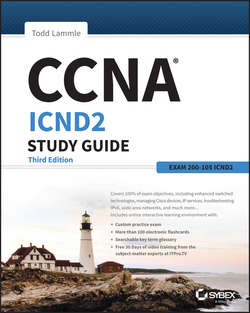Читать книгу CCNA ICND2 Study Guide - Lammle Todd - Страница 6
На сайте Литреса книга снята с продажи.
Answers to Assessment Test
Оглавление1. B. To allow for the PVST+ to operate, there's a field inserted into the BPDU to accommodate the extended system ID so that PVST+ can have a root bridge configured on a per-STP instance. The extended system ID (VLAN ID) is a 12-bit field, and we can even see what this field is carrying via show spanning-tree command output. See Chapter 1 for more information.
2. A. Cisco's EtherChannel can bundle up to eight ports between switches in order to provide resiliency and more bandwidth between switches. See Chapter 1 for more information.
3. B, C, E. All the ports on both sides of every link must be configured exactly the same between switches or EtherChannel will not work. Speed, duplex, and allowed VLANs must match. See Chapter 1 for more information.
4. A, B. Southbound APIs (or device-to-control-plane interfaces) are used for communication between the controllers and network devices, which puts these interfaces between the control and data planes. See Chapter 8 for more information.
5. D. Class of Service (CoS) is a term to describe designated fields in a frame or packet header. How devices treat packets in your network depends on the field values. CoS is usually used with Ethernet frames and contains 3 bits. See Chapter 8 for more information.
6. C. When traffic exceeds the allocated rate, the policer can take one of two actions. It can either drop traffic or re-mark it to another class of service. The new class usually has a higher drop probability. See Chapter 8 for more information.
7. C, D, F. The SDN architecture slightly differs from the architecture of traditional networks. It comprises three stacked layers: data, control and application See Chapter 8 for more information.
8. C. NBAR is a layer 4 to layer 7 deep-packet inspection classifier. See Chapter 8 for more information.
9. B, D. Each stack of switches has a single IP address and is managed as a single object. This single IP management applies to activities such as fault detection, VLAN creation and modification, security, and QoS controls. Each stack has only one configuration file, which is distributed to each member in the stack. When you add a new switch to the stack, the master switch automatically configures the unit with the currently running IOS image and the configuration of the stack. You do not have to do anything to bring up the switch before it is ready to operate. See Chapter 8 for more information.
10. B. There is no IPv6 default gateway, which will be the link-local address of the router interface, sent to the host as a router advertisement. Until this host receives the router address, the host will communicate with IPv6 only on the local subnet. See Chapter 6 for more information.
11. D. The command
show ipv6neighbors provides the ARP cache on a router. See Chapter 6 for more information.12. A. The state is STALE when the interface has not communicated within the neighbor reachable time frame. The next time the neighbor communicates, the state will be REACH. See Chapter 6 for more information.
13. C. There are two successor routes, so by default, EIGRP was load-balancing out s0/0 and s0/1. When s0/1 goes down, EIGRP will just keep forwarding traffic out the second link, s0/0. S0/1 will be removed from the routing table. See Chapter 3 for more information.
14. F. There isn't a lot to go on with the output, but the only commands that provide the FD and AD are
show ip eigrp topologyandshow ipv6 eigrp topology. The addresses in the output are link-local IPv6 addresses, so our answer is the latter. See Chapter 3 for more information.15. A, B, C, D. Cisco has documented steps, according to the objectives, that you must go through when troubleshooting an adjacency. See Chapter 3 for more information.
16. B, D, E. In order for two OSPF routers to create an adjacency, the hello and dead timers must match, and they must both be configured into the same area as well as be in the same subnet. See Chapter 6 for more information.
17. A. The process starts by sending out Hello packets. Every listening router will then add the originating router to the neighbor database. The responding routers will reply with all of their Hello information so that the originating router can add them to its own neighbor table. At this point, we will have reached the 2WAY state – only certain routers will advance beyond this. See Chapter 5 for more information.
18. C. Referred to as summary link advertisements (SLAs), Type 3 LSAs are generated by area border routers. These ABRs send Type 3 LSAs toward the area external to the one where they were generated. See Chapter 5 for more information.
19. B. AH checks the entire packet, but it doesn't offer any encryption services. See Chapter 7 for more information.
20. B. GRE is a generic tunnel protocol that has no built-in security. The rest of the options are correct for GRE tunnels. See Chapter 7 for more information.
21. B. Platform as a Service (PaaS) provides the operating system and the network by delivering a computing platform and solution stack. See Chapter 8 for more information.
